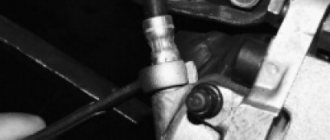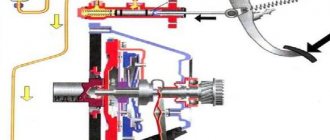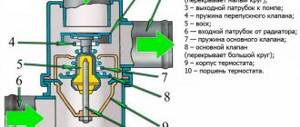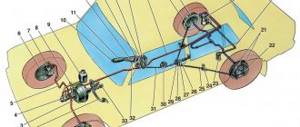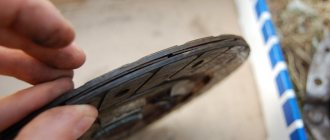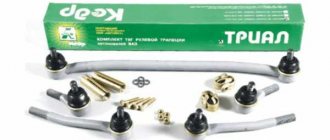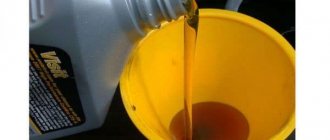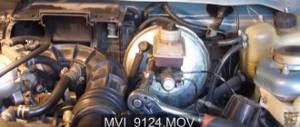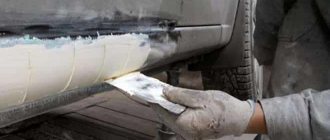Disassembly and assembly of the main brake cylinder VAZ 2107, VAZ 2105, VAZ 2104, Lada Zhiguli, Classic
Main cylinder of the hydraulic brake drive of VAZ 2104, VAZ 2105, VAZ 2107: 1 - plug; 2 — cylinder body; 3 — rear brake drive piston; 4 — washer; 5 — front brake drive piston; 6 - sealing ring; 7 — locking screws; 8 — piston return springs; 9 — spring plate; 10 — pressure spring of the sealing ring; 11 - spacer ring; 12 — inlet; A - compensation hole (gaps between sealing ring 6, spacer ring 11 and piston 5)
Details of the master cylinder for the Lada Classic brake drive: 1 - cylinder body; 2 — lock washer; 3 - fitting; 4 - sealing gasket; 5 - sealing washer; 6 — piston lock screw; 7 — piston return springs; 8 - cup; 9 — pressure spring of the sealing ring; 10 - sealing ring; 11 - spacer ring; 12 — rear brake drive piston; 13 — washer; 14 — front brake drive piston
Unscrew the locking screws 7 and remove all the parts in order. Assemble the cylinder of a VAZ 2107, VAZ 2105, VAZ 2104 in the reverse order of disassembly. In this case, lubricate the parts with brake fluid. When assembling, use tool 67.7853.9543.
Brake system
The braking system of the Zhiguli car uses many design solutions that have not previously been seen on domestic passenger cars - front wheel disc brakes, a dual brake master cylinder, a pressure limiter, and aluminum rear brake drums. Since they are unfamiliar to most car enthusiasts, we will pay special attention to them. First of all, we must say about the dual-circuit hydraulic brake drive system. For the first time, two independent piping circuits supplying fluid to the front and rear wheel brakes appeared in the late 1930s on racing cars, where brake reliability is of paramount importance. If a hose breaks or there is a fluid leak in one circuit, the other circuit does not fail, and the car can be braked. Several years ago, this solution was adopted by designers of production passenger cars. They placed the two master cylinders, which run in parallel on racing cars, one behind the other in a common housing to make the unit more compact. Passenger cars also inherited disc brakes from their racing counterparts, on which they have been successfully used for seventeen years. The higher efficiency of disc brakes compared to drum brakes is the reason why they are most often equipped with the front wheels, which account for a significant portion of the braking force. The rear brakes of the Zhiguli are made of drums, since they are less loaded. In addition, this design simplifies the operation of the hand brake. It was also taken into account that the rear disc brakes, bombarded by a stream of dirt and dust from under the front wheels, would wear out too quickly when operating the car on country roads. To ensure that the rear brakes of the Zhiguli were not heavy and were well cooled, they were equipped with aluminum drums with cast iron rings poured into them, on which the pads work. Another important feature of the Zhiguli brake system is the pressure regulator. When a car brakes sharply, a redistribution of loads always occurs - the car “nods”, and the load on the rear wheels decreases. As a result, their grip on the road deteriorates and they “skid.” This phenomenon (if the driving wheels are rear), especially when driving on a snowy and wet road, leads to the rear of the car skidding, and sometimes to accidents - in this case the car loses controllability. Obviously, depending on the load on the rear wheels (number of passengers, amount of luggage, weight redistribution during sudden braking), it is necessary to regulate the fluid pressure, and therefore the braking force on the rear wheels. Then skid will be prevented. The sensor of such an “automatic” regulator is a mechanical connection between the rear axle and the body, the distance between which varies depending on the load on the rear axle. Let us now consider specifically each node of the system.
Installing the brake pedal
: 1 - main brake cylinder; 2 - pusher; 3 - pedal; 4 — adjustable stop and brake light switch; 5 - lock nut; 6 — tension spring; 7 — pedal bracket.
As on most modern passenger cars, the brake pedal is made suspended and is mounted together with the clutch pedal on the axis of bracket 7. Its end is pressed against the front panel of the body and (screwed to it together with the main cylinders for the brake and clutch drive with nuts on four studs. Pedal 3, through pusher 2, acts on the piston of the master brake cylinder, which supplies fluid to the brakes. When the pedal moves, the brake light switch 4 is immediately activated, on the pusher of which it rests in the initial position. The full pedal stroke is about 140 mm.
Master brake cylinder
: 1 - plug; 2 - body; 3 — rear brake drive piston; 4 — front brake drive piston; 5, 9 — sealing ring; 6, 10 — fixing bolt; 7, 11 — spring; 8 — thrust washer; 12 — installation ring; 13 — inlet; 14 - pressure spring.
Repair of the main brake cylinder on a VAZ 2107
A serviceable brake system of a VAZ 2107 car is the key to the safety of both the driver and passengers. It is for this reason that special attention should be paid to it, and if the slightest sign of malfunction appears, repairs should be started immediately.
The main brake cylinder on the VAZ 2107 is one of the main elements of the car’s braking system. It may have two main faults. The first is expressed in the appearance of a fluid leak from the main brake, the second in a decrease in the efficiency of the system, which can only be determined after checking the workers. In most cases, both faults can be eliminated by simple repair of the main brake, which consists of replacing the sealing collars and boot. However, in some cases, only replacing the cylinder can solve the problem.
First, you need to disassemble the brake cylinder and determine whether it is advisable to repair it. To work you will need a minimum of tools:
- The key for 10 is normal;
- Special key for 10, for pipes;
- Key to 13;
- The screwdriver is flat.
The main cylinder is located in the engine compartment of the VAZ 2107, on the partition between the engine compartment and the passenger compartment. Before removing it, you need to disconnect the hose from the fluid reservoir and two tubes one by one:
- Before disconnecting the hose, it is recommended to remove the brake fluid from the reservoir to avoid spilling it. The procedure is extremely simple - loosen the clamp and remove the hose.
- We unscrew the tubes using a special 10mm wrench.
Now that all the inlet and outlet pipes are disconnected, use a 13mm wrench to unscrew the nuts securing the cylinder to the body and remove it.
Now you should disassemble the master brake cylinder and inspect it to see if it can be repaired. There shouldn’t be any problems here either – you just need to unscrew the locking screws one by one, starting from the plug. When unscrewing the second screw, hold the piston so that it does not jump out under the influence of the spring. The first piston will come out on its own, the second will need to be knocked out by knocking the body on a piece of wood.
Having pulled out both pistons with springs, inspect the cylinder mirror for any holes, scratches, or other damage. If the mirror is clean, then repair is possible, otherwise, replace the main brake with a new one.
Since the replacement itself should not cause problems, we will further describe the case when repairs make sense. Purchase a repair kit for your brake master cylinder.
Remove all o-rings from the pistons and thoroughly wipe all parts: pistons, springs, housing.
We put on new sealing cuffs and assemble the master cylinder in the reverse order. We screw it to the body, connect the tubes and the hose from the tank. We do not tighten the tubes completely, pour new liquid into the tank and, as soon as it begins to flow out from under the tubes, we screw them in completely. Most likely, after final assembly, the system will need to be bled to remove air bubbles. In essence, this involves a complete replacement of the fluid.
Important points
When repairing the brake system of a VAZ 2107, you should remember several very important nuances. Without mentioning them, this article would be incomplete. So:
- On later VAZ 2107 models, spring washers began to be installed under the fastening bolts of the brake brackets. They are thin and very easy to lose when removing the bracket. To prevent this from happening, it is advisable to spread some newspaper or rag under the caliper. If the puck does pop out, it will be much easier to find it;
- If the driver does not plan to change the brake pads when replacing the caliper, then before removing them they should be marked with a marker or chalk so that they can be installed in the same place during reassembly. If you change the original location of the pads, they will become unusable much faster;
- If the driver decides to leave the caliper in place and plans to change only the brake pads, then he will have to buy not one, but two sets of pads, since these parts are always changed on two wheels, and not on one. If you leave old pads on one of the wheels, this will inevitably lead to rapid wear and new problems in the operation of the brake system;
So, replacing a brake caliper is not at all as difficult a task as it might seem at first glance. The main thing that the driver should remember when changing this part is its extreme importance. If a mistake is made when installing the caliper or pads, this does not bode well for either the driver or the car. It is for this reason that the article described in as much detail as possible all the nuances of installing a brake caliper. And it is strongly recommended to pay close attention to these nuances.
labavto.com
The brake master cylinder (MBC) is one of the main elements of the brake system, which determines how safe the vehicle will be used. The driver is obliged to ensure that it is in good condition. If malfunctions are detected, action must be taken immediately. Negligence and delay in repairs can lead to an accident. You can identify faults and repair the VAZ 2107 GTZ yourself.
GTZ: device and purpose
The VAZ 2107 is equipped with a hydraulic brake system consisting of two circuits. When one of the circuits fails, the other continues braking. This improves traffic safety. The master cylinder changes the pressure in the circuits depending on the position of the brake pedal. The GTZ is located on the rear wall of the engine compartment. It can be found under the expansion tank of two sections, which is filled with brake fluid (TF). It looks like an oblong cylinder with holes for connecting brake hoses.
The GTZ housing contains 2 pistons with sealing collars. They are located sequentially one after another. The first one moves due to the influence of the pedal pusher on it and serves the contour of the rear wheels. It forces a second piston to move, which acts on the two brake circuits of the front wheels. Springs that are located between the pistons return them to place when the driver releases the brake pedal.
GTZ performs the following functions:
- distributes the fuel fluid over two brake circuits, which separately serve the front wheels;
- transmits the force of the brake pedal using fluid to the working cylinders (WC);
- directs excess fuel fluid to the expander;
- returns the pedal and rod to their initial position when the driver no longer presses the pedal.
To avoid problems with the brakes during further operation, for replacement you need to buy an original product, preferably from a Tolyatti plant with article number 21013505008.
Diagnostic methods and possible malfunctions of the GTZ
The need to diagnose HTC arises when the following symptoms appear:
- an indicator lights up on the dashboard warning of insufficient brake fluid level;
- in order to brake, you need to press the pedal hard;
- large free play of the pedal, sometimes it falls through;
- when braking sharply, the car moves away from the direction of travel;
- the car slows down, the pedal is depressed as much as possible;
- leakage of fuel fluid from the tank.
First, the area under the gas turbine engine is inspected for drips. They are usually visible on the side member and vacuum booster. If the tank body is intact, you need to remove and repair or replace the GTZ.
To identify malfunctions of the master cylinder without diagnosing other parts of the brake system, you need to perform the following steps:
- Using a wrench, unscrew the brake pipes from their sockets and screw in screws with fine threads in their place;
- plug the outlet openings of the dismantled removed pipes with wooden choppers or pegs;
- Next you need to press the pedal several times.
If the GTZ is working properly, after several presses the chambers will fill with liquid and it will be impossible to press the pedal. On the faulty element, the sealing cuffs allow liquid to pass through, and it flows back into the expander, and the pedal continues to fail. To confirm a malfunction of the turbocharger, you need to unscrew the nuts on the cylinder and move it away from the vacuum booster; the fuel fluid will flow out of the hole.
Sometimes the seals of the second chamber become unusable, while in the first they cope with their function. In this case, when checking, the brake pedal will fall slower. If the gas turbine engine is working properly, the pedal cannot be pressed more than 3 times, since there is nowhere for fluid to flow out of the cylinder.
How to replace the GTZ and change the cuffs
Problems with GTZ are solved in two ways:
- Disassembling and cleaning the device and replacing the seals from the repair kit.
- Complete replacement of the GTZ.
How to bleed the brakes on a VAZ 2107 yourself (Video, photo)
When is it necessary to pump the brakes of a VAZ 2107
It is necessary to bleed the brake system in four cases:
- Replacing brake fluid. Brake fluid has a limited service life. Over time, it absorbs moisture from the air, which can cause corrosion of the surface of the brake cylinders and their failure. Water also worsens the main property of brake fluid - it reduces the boiling point.
- The recommended service life of brake fluid on VAZ cars is 2 years, after which it is worth replacing it. This applies to standard glycol-based brake fluid.
- Troubleshooting the brake system. When replacing brake hoses and cylinders, brake fluid leaks and air enters the system. Therefore, after repair work, the VAZ 2107 brakes must be bled.
- Air ingress during operation. This manifests itself in deterioration in braking efficiency, a “soft pedal” or uneven braking of individual wheels.
What is needed to bleed the brake system
It is almost impossible to bleed the brake system yourself. The work is carried out by two people. One person (“mechanic”) works with the brake system, unscrews the fittings. The second (“partner”) is located inside the car and must press or release the brake pedal on command.
You also need the following tools:
- 8/10 socket wrench;
- a PVC tube or rubber hose, the inner diameter of which corresponds to the diameter of the fitting;
- container for collecting waste liquid.
- Brake fluid is also needed.
How to bleed the brakes on a VAZ 2107
For ease of work and to ensure free access to the brake cylinder fittings, you should use an inspection hole. The design of the front brake mechanisms requires removal of the wheels to bleed the brake system.
Before starting work, it is necessary to fill the brake reservoir to the maximum, and during bleeding, you must ensure that it is constantly filled with brake fluid. If you miss this moment, air will get into the working cylinder and you will have to start work again.
The procedure for each of the 4 working cylinders is as follows:
- Remove the protective cap from the fitting.
- Loosen the fitting using a spanner. If the fitting has not been unscrewed for a long time, significant effort may be required. You must be especially careful not to damage the edges, otherwise the work may become very difficult, even to the point that the brake cylinder will need to be replaced.
- Place the tube on the fitting and lower it into the brake fluid container.
Direct pumping is performed as follows:
- The “partner” sitting in the cabin, at the command of the “mechanic”, presses the pedal all the way.
- The “mechanic” unscrews the fitting half a turn so that the liquid, along with air bubbles, comes out into the container through the inserted tube. The brake pedal “sinks” to the floor.
- The “fitter” tightens the fitting, and the “partner” releases the pedal on command.
The procedure is repeated until no more air bubbles come out of the tube. During bleeding, the end of the tube must be constantly lowered into the brake fluid so that air does not enter the cylinder.
In this way, all four working brake cylinders are pumped. A certain sequence should be followed when bleeding the cylinders. They are pumped “from far to near”:
- Right rear.
- Left back.
- Right front.
- Left front.
After completing bleeding of each cylinder, it is necessary to tighten the fitting and put on the protective cap.
Bleeding the brakes of a VAZ 2107 is quite feasible at home and does not require expensive special tools and devices. No special qualifications are required either. Even a child can release and press the brake pedal at the “locksmith’s” command.
Often, owners upgrade the brake system by installing more efficient, high-quality and expensive parts. However, this does not change the bleeding method in any way and does not eliminate the need for periodic work to replace the brake fluid.
semerkavaz.ru
Main breakdowns of the GTZ
The master brake cylinder of the VAZ-2107 constantly contains fluid, which can leak out if it breaks down. There are two malfunctions in total - leakage of fluid from the turbocharger, as well as a significant drop in the efficiency of the braking system. Usually, all breakdowns are eliminated by repairing (replacing) the master cylinder and bleeding the system.
To repair the cylinder, you will need to replace almost all of its components: boots, cuffs, and, if necessary, pistons. But sometimes repairs are impractical, so it is better to completely replace the mechanism. If there is significant wear on the inner walls of the cylinder, this will lead to loss of tightness even when new o-rings are installed.
Removing the master cylinder
Before dismantling, you will need to drain the fluid from the expansion tank and remove the pipes. Then you will need to do the following:
- Using a special “10” wrench, loosen all pipes.
- Unscrew the tubes completely using a regular key to “10”. It is advisable to place a rag underneath so that the brake fluid does not get on the body parts.
- After disconnecting the GTZ from the system, it is necessary to unscrew the nuts using a wrench set to “13” that fasten it to the vacuum booster housing.
This completes the dismantling. The brake cylinder must be replaced in exactly the reverse order. But if it is possible to make repairs, disassemble the cylinder.
How to disassemble the GTZ?
An exact answer to whether repairs can be made can only be given after you disassemble the master brake cylinder of the VAZ-2107. To do this, you just need to perform simple manipulations:
- Unscrew the first locking screw and remove the piston and spring.
- Unscrew the second locking screw; you need to cover the hole with your finger, as the piston may jump out.
If the piston suddenly jams, you need to knock it out - to do this, tap on the master cylinder body with a small wooden block. Be sure to inspect:
- There should be no scratches, holes or other damage on the mirror inner surface.
- The threads in the holes for the locking screws must be intact.
- The cylinder must not have an elliptical hole.
If there is no damage, repairs can be made. To do this, use a special brake cylinder kit. Its price is much lower than the assembled mechanism - about 80-100 rubles, depending on the manufacturer. The cost of a new GTZ is at least 700 rubles.
You will need to remove all the O-rings and wipe the parts - body, springs and pistons. After this, put on the cuffs and assemble the master brake cylinder of the VAZ-2107. Do it in the reverse order; the tubes need to be tightened with great effort, but without fanaticism. After filling the fluid, bleed and inspect for leaks. If there are any, then it is necessary to tighten the fittings more. If liquid comes out from under the hole near the vacuum seal, you will have to replace the entire cylinder.
